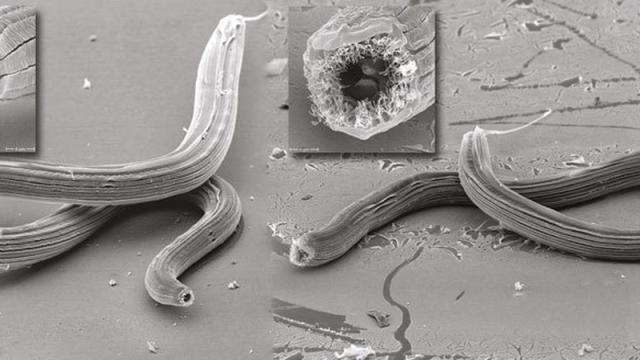A German research team recently discovered what they thought were five distinct species of nematode worms on account of significant facial differences. But it turns out they’re a single species of worm — a fascinating creature that changes the shape of its mouth depending on what food is available.
The newly described nematode worm, a roundworm dubbed Pristionchus borbonicus, was discovered on Réunion Island in the Indian Ocean by a German research team led by Ralf Sommer and Matthias Herrmann from the Max Planck Institute of Developmental Biology. These worms, which live inside fig plants, have an assortment of food choices, from yeast and bacteria through to other roundworms. And it appears they have evolved the ability to alter their facial characteristics to take advantage of the resources available.
After looking at the worms through a microscope, the researchers observed five distinct mouth forms, hence the assumption that they had stumbled upon a sizeable trove of new nematode types. It was only after the researchers sequenced the worm genome that they were able to confirm that they were in fact dealing with a single — but highly adaptable — nematode.
The Max Planck researchers say this is a rather extreme example of evolutionary divergence. This happens when a single species is able to change its shape and form depending on the environmental context. In this case, the worms can develop a short and wide mouth, with a single characteristic tooth, for carrying out predatory attacks. Or it can develop a narrow mouth suitable for grazing on bacterial food sources.
“The different mouth forms of Pristionchus borbonicus, that we have found now, are specialised for the preferred intake of bacteria, yeasts or other roundworms,” noted Sommer in a release. “So, obviously they occupy different ecological niches within the fig. With this team of specialists the species can exploit a large food spectrum and efficiently buffer fluctuations in the availability of a certain resource by changing the proportion of mouth forms.”
The worms likely play a role in the rather complex co-evolved ecosystem occupied by fig fruits, fig wasps, and a significant number of bacteria, yeasts, and other microbes. Nematodes hitch a ride on tiny pollinating fig wasps to reach new flowers. The researchers aren’t entirely sure how Pristionchus borbonicus is contributing to this dynamic, so they’re going to turn their attention to this, along with an attempt to find new figs and worms on Réunion Island.
